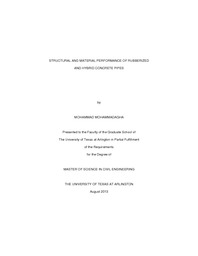| dc.description.abstract | This study investigates how the combination of steel fiber, crumb rubber, synthetic fiber, and conventional steel cage will improve the ductility of regular concrete pipes and thin-walled semi-rigid concrete pipes. In this study, pipes with four different concrete mixtures were produced and tested: (1) Steel Bar Reinforced Concrete Pipe (SBRCP), (2) Crumb Rubber Reinforced Concrete Pipe (CRRCP), (3) Steel Fiber Reinforced Concrete Pipe (SFRCP), and (4) Synthetic Fiber Reinforced Concrete Pipe (SNFRCP). This study investigates how the variation of the fiber volume fraction and crumb rubber content in concrete mix affects the behavior of pipes with diameters ranging from 24in. (610 mm) to 60in. (1524 mm).In this research, the crumb rubber particles were replaced from 3% to 20% (by volume) of sand in the mixture of concrete pipes. Steel fibers (RC-65/35-BN, Bekaert) used in this study have a hooked end shape with a length of 1.38 in. (35 mm), a diameter of 0.022in (0.55 mm) and an aspect ratio of 65 with dosages of 10 (Volume fraction of 0.08%), 11 (Vf of 0.08%), 22 (Vf of 0.17%), 44 (Vf of 0.33%), 66 (Vf, of 0.5%) and 88 lb/yd3 (Vf of 0.67%). Macrosynthetic fibers were from BASF MasterFiber<sup>TM</sup> MAC Matrix with dosages of 2, 4, 5, and 8 lb/yd3.A total of 86 pipes were produced and tested in accordance with ASTM C 497 three-edged bearing at Hanson Precast Plant in Grand Prairie, TX. In addition, a total of 233 cylindrical specimens, 4in. (101.6mm) in diameter and 8in. (203mm) in height, were tested in 1, 3, 7 and 28 days. Moreover, a total of 57 beam specimens, 20in. (508mm) in length, 6in. (152mm) in width and height were produced and tested at the Civil Engineering Lab Building (CELB) at the University of Texas at Arlington. Test results revealed that as the crumb rubber content increased the compressive strength of pipes decreased; however, ductility and energy absorption enhanced over conventional concrete. | en_US |


